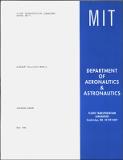| dc.description.abstract | Introduction: The threat of midair collisions is one of the most serious problems facing the air traffic control system and has been studied by many researchers. The gas model is one of the models which describe the expected frequency of midair collisions. In this paper, the gas model which has been used, so far, to deal only with simple cases is extended to a generalized form, and some special types of collision models, such as the overtaking model, are deduced from this generalized model. The effects of the probability distributions of aircraft direction and altitude on the frequency of collisions are also analyzed. The results in this paper can be applied to evaluate the frequency of conflicts as well as that of collisions. In this paper, an aircraft is represented as a circular cylinder, and a collision is described as an overlap of two cylinders. If the size of the cylinder is expanded to the volume of the protected airspace of an aircraft, an overlap of two cylinders means a conflict. Therefore, with a slight modification, the results can be used to analyze the frequency of conflicts. This flexibility gives the models of this paper an important potential for application to a future air traffic control system. The FAA is currently developing a new type of air traffic control system called AERA (automated en route air traffic control). AERA is expected to reduce the workload of human controllers and expand the capacity of airspace using new computer systems and better communication links. When this system is fully implemented, aircraft will be able to fly under fewer restrictions. However, if many aircraft are flying on random routes, the frequency of potential conflicts the computer system should handle becomes high. Therefore, the frequency of potential conflicts under various circumstances should be calculated in order to estimate the computer workload before full implementation of the system. The models developed in this paper may be helpful in this evaluation. The consequences of actual collisions are, of course, grave. Fortunately, the average number of such collisions per year has remained relatively small. According to an FAA Report (Report of the FAA Task Force on Aircraft Separation Assurance, Jan. 1979), the average number of midair collisions reported to NTSB from 1974 through 1978 was 33 per year. Most midair collisions have occurred between small general aviation aircraft operating under VFR. However, the report also states that there were 227 near midair collision reports in 1975 alone, and that air carriers were involved in 68 of these cases. (According to the report, a near midair collision is an incident which would probably have resulted in a collision if no action had been taken by either pilot. Closest proximity of less than 500 ft would usually be required for a near midair collision report.) Although the number of conflicts is not available in the report, it is clearly far greater than the number of near midair collisions considering the difference of airspace volumes involved. The outline of this thesis is as follows. In Chapter 2, we present an overview of two aircraft collision models, the Reich model and the gas model, which have been the most important ones in this field. In Chapter 3, we develop some extensions of the gas model including a generalized two-dimensional gas model, an overtaking model and a three dimensional gas model. In Chapter 4, we develop an aircraft collision model which does not assume the uniformity of aircraft distribution. The conclusions of this thesis are summarized in Chapter 5. | en_US |
